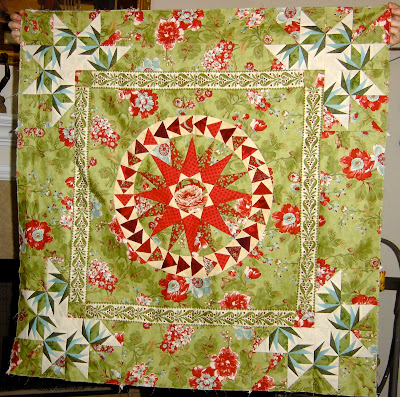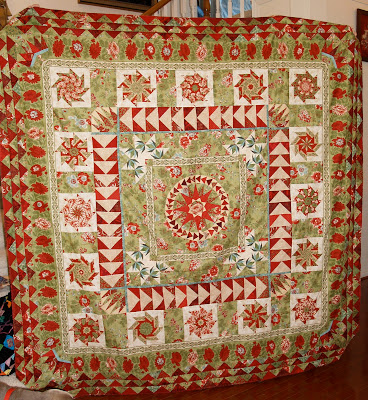I am not afraid of storms for I am learning how to sail my ship.
At home I opened up my first assignment and laid it all out. I read the specifications its owner had included, took a deep breath and drew a blank.
I put it all neatly away and repeated the process again every couple of days for a few weeks.
Nothing was clicking.
It was not colors I liked.
I would have never looked twice at the focal fabric for the quilt. (The green background with large floral prints) I had never considered having to work with fabrics I didn't personally feel inspired by.
Here was a challenge!
I decided it was time to look at it in a different way.
I stopped thinking about the fabrics and just thought about the design. What color should come next? When I put different fabrics beside it I decided the green focal fabric should be around it so it would look like it was floating in the green but I wanted a little zing with it...
I had never designed anything quilt related. I had always followed patterns. Here I had to pick and possibly design a border for this quilt top and pick the fabrics and HOPE that the owner would like it!
The cardinal rule of Round Robins is to always work on your assignments as carefully as you want your group members to work on yours!
What was I good enough at that would live up to the potential of this carefully constructed medallion? Paper piecing. You could do anything with paperpiecing and I had the skills so off I went looking at paper piecing patterns online, from magazines, books etc....
The result: A huge pile of no's and a few maybe's (oh and a big big mess).
The medallion's circle of red flying geese around a mariners compass type of star really said movement. One of the owners notes was that the ice blue color was to be an accent not a prominent color in the overall product. It needed to end up Queen size so I had plenty of room no worries there.
Nowadays, one could be really slick and plug this into a program like EQ and do all your auditioning and experiments on it digitally but, I wasn't even aware of that existing yet. ( Hmmm....note to self: a virtual Round Robin using EQ software with a group of ladies????)
Deadline 2 weeks away, plenty of time. I had to read up on the basics of adding borders to quilts. The group had said that a danger of round robin quilts is that they won't lay flat because people apply the borders incorrectly. You have to MEASURE and not just slap it on and cut off the extra border fabric. It was a new concept and ever eager to do things correctly I made my calculations.
Here was another speed bump: it was an irregular size (not perfectly square) Can you imagine! Now that would never happen to anyone else right?? Your projects are always perfect right? ha-ha
But how does that work in this situation? How do I make an increment that will work out???
Answers:
1. You design to suit the measurement you have.
2. You can add a floating border to the block to bring it to a reasonable measurement- not an option here because it already had a border print around it so it wouldn't suit the medallion to do so.
3. Do lots of complicated math to make your increments work out to fit the existing quilt.
I opted for #1. I did my main design element on the corners which included paper piecing a 3/4 block (from a book by Carol Doak on Fifty State Stars) around each corner and filling in the rest with the focal fabric to the needed measurement. I wanted to mirror or continue that movement of the flying geese around the center. Here is what I came up with:
And Here is how this quilt finished out after everyone made their rounds on it.
The border after mine repeated flying geese but in reversed colors and on a much larger scale. Then came some stack and whack type of blocks, a ring of just the roses, and lastly three rounds of elongated triangles which framed the whole quilt.
It was interesting that fabric I was not inspired by at the beginning certainly played out into a beautiful quilt.
On to the next rounds...














